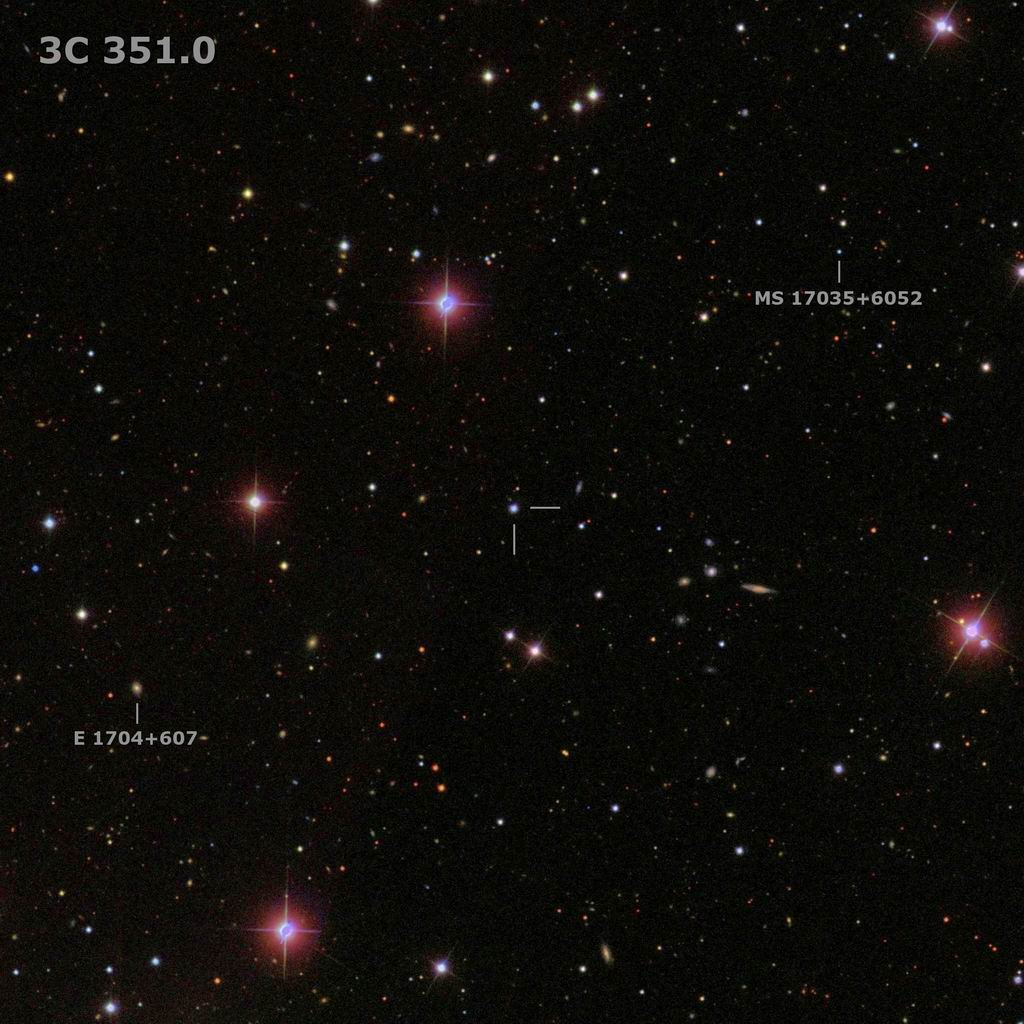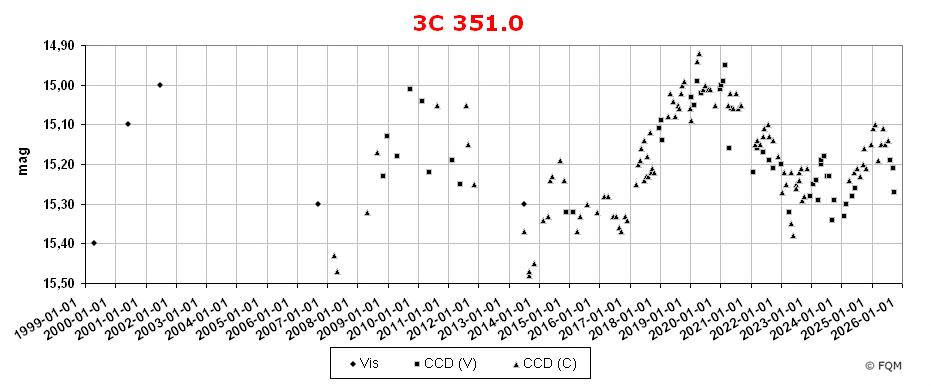
| Frankfurt Quasar Monitoring |
| 3C 351.0 |
| Cross-Identifications | SBS 1704+608, PG 1704+608, OT+607, S4 1704+60 LEDA 2817694, HS 1704+6048, 1704+608, 4C 60.24 7C 1704+6048, 87GB 170404.7+604847, NRAO 522 SDSS J170441.37+604430.5, 1ES 1704+607, 3C 351 1RXS J170441.9+604423, 1H 1704+605, DA 430 |
| Equat. coordinates | RA 17 04 41.5 DE +60 44 28 (J2000) |
| Constellation | Draco |
| Type | QSO |
| Redshift | z=0.371 |
| Distance (2) (3) |
1405 Mpc |
| Total mag range (mv) (4) | 14.6 - 16.3 |
| Catalog Magnitude (1) | 15.43 |
| Absolute Magnitude (1) | -26.1 MB |
| Light Travel-Time (2) | 3.913 × 109 yrs |

Comparison stars
| star | B | V | Rc | Ic |
| 2 | 14.094 (0.007) | 13.276
(0.002) |
12.810
(0.002) |
12.386
(0.002) |
| 6 | 15.422
(0.040) |
14.676
(0.007) |
14.246
(0.005) |
13.873
(0.005) |
| 8 | 16.873
(0.088) |
15.927
(0.023) |
15.482
(0.015) |
15.097
(0.016) |
| 9 | 17.314
(0.106) |
16.064
(0.069) |
15.409
(0.014) |
14.785
(0.012) |
| 18 | 17.144
(0.211) |
16.557
(0.061) |
16.030
(0.026) |
15.605
(0.025) |
| 22 | 16.364
(0.064) |
15.417
(0.015) |
14.960
(0.010) |
14.549
(0.010) |



| 3C
351 is a variable radio loud quasar in southern Draco, some 6° NW of
Draco´s head. This quasar was
discovered as a radio
source during the 3. Cambridge Radio Survey (3C) in 1959. Since then, this quasar has
been cataloged by several other radio surveys (e.g. 4C, 7C, 87GB).
3C 351 is a lobe-dominated, radio-loud
quasar with a complex radio structure (type FR II). In the optical, 3C
351 was first identified with a blue stellar object
in 1965 during spectroscopic investigations of a sample of 3C-radio
sources. Here the object was
classified as a quasar, after the first redshift of z=0.371 was
determined during
this observing campaign. As a blue stellar object, this quasar
was also identified by both the
Palomar-Green Bright Quasar
Survey (PG) in the late 1970s and the
Second Byurakan Survey (SBS) in the early 1980s.
Besides the radio and the optical, 3C 351
was also detected as an X-ray source in 1979 by the Einstein satellite
(HEAO 2). The
host galaxy of this quasar is an elliptical galaxy of type E3 (see
Hubble Space Telescope
image above). 3C 351 is a moderately variable object with a total range of nearly 2 magnitudes in the optical. CCD observers, as well as visual observers, shall use the comparison stars given above. The comparison stars 2=13.276 and 6=14.676 are recommended for both unfiltered and v-mag photometry. Another photometric sequence was published by Angione (1971). Visual observers need at least a 10- to 12-inch telescope or larger to glimpse this quasar as a faint stellar object at a distance of 3.9×109 light-years. Even with large instruments the quasar remains stellar. To locate quasar 3C 351, just move your telescope 5° to the east of Eta Draconis until you reach a 6.1-mag field star (HD 154391), only 25´W of 3C 351. ____________
Stargazers who like to observe more very old quasi-stellar photons may turn to 2 other quasars, located at the same whopping distance of about 3×109 light-years: The first is quasar KUV 18217+6419, a bright 14-mag object, 9.6° ENE of 3C 351, followed by quasar PG 1700+518, another bright 14-mag object, 9° S of 3C:351. In addition, CCD observers may also recognize faint quasar MS 17035+6052 (17m.5, z=1.358*) and nearby AGN E 1704+607 (=PGC 59581, 17m.73, z=0.080*) in their CCD frames of 3C 351 (see colour chart above). (* Data from Véron-Cetty & Véron 2006) Some interesting deep sky showpieces are worth visiting. By looking 8.5° to the NE you will find the showpiece planetary NGC 6543, also known as the "Cat´s Eye Nebula". NGC 6543 is rich in details and one of the brightest objects of its class. 13° to the south will bring you to globular cluster NGC 6229, considered to be about 100 000 light-years distant. The brightest stars in NGC 6229 are of mag 15.5, so you will need at least 12- to 14-inch of aperture to resolve some few very faint stars of NGC 6229. Finally, some bright galaxies are worth visiting: NGC 6503 (10m.9, 10°N), NGC 6015 (11m.7, 9°E), NGC 5985 (11m.9, 10°E), and finally M 102=NGC 5866 (10m.8, 15°E), together with the associated edge-on galaxy NGC 5907 (11m.1, 15°E). |
| Angione, R.J. 1971, AJ, 76, 412; Photoelectric Sequences for the Brighter QSO´s. Angione, R.J. 1973, AJ, 78, 353; QSO historical light curves. Boyce, P.J., Disney, M.J., et al. 1998, MNRAS, 298, 121; HST Planetary Camera images of quasar host galaxies. Bridle, A.H., Hough, D.H., et al. 1994, AJ, 108, 766; Deep VLA imaging of twelve extended 3CR quasars. Gonzàlez-Pérez, J.N., et al. 2001, AJ, 122, 2055; Optical and Near-Infrared Calibration of AGN field stars: An All-Sky Network of faint stars calibrated on the Landolt System. Lynds, C.R., Stockton, A.N., Livingston, W.C. 1965, ApJ, 142, 1667L; New Spectroscopic Observations of Quasi-Stellar Sources. Márquez, I., Petitjean, P., et al. 2001, A&A, 371, 97M; Adaptive optics imaging of low and intermediate redshift quasars. Riffel, R., Rodríguez-Ardila, A., Pastoriza, M.G. 2006, A&A, 457, 61R; A 0.8-2.4 ?m spectral atlas of active galactic nuclei. Schmidt, M., Green, R. 1983, ApJ, 269, 352; Quasar Evolution derived from the Palomar Bright Quasar Survey and other complete Quasar Survey. Steinicke, W.; Katalog heller Quasare und BL Lacertae Objekte; Umkirch 1998. Tananbaum, H., Avni, Y., et al. 1979, ApJ, 234, 9L; X-ray studies of quasars with the Einstein Observatory. Véron-Cetty, M.-P., Véron, P. 2001, A&A 374, 92; A Catalogue of Quasars and Active Nuclei: 10th edition. Véron-Cetty, M.-P., Véron, P. 2003, A&A 412, 399; A Catalogue of Quasars and Active Nuclei: 11th edition. Véron-Cetty, M.-P., Véron, P. 2006, A&A 455, 776; A Catalogue of Quasars and Active Nuclei: 12th edition. Véron-Cetty, M.-P., Véron, P. 2010, A&A 518, 10; A Catalogue of Quasars and Active Nuclei: 13th edition. |
| Links: Hamburg Quasar Monitoring Sloan Digital Sky Survey |
| home |